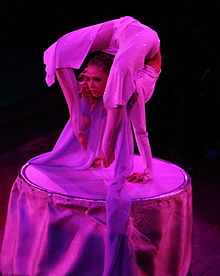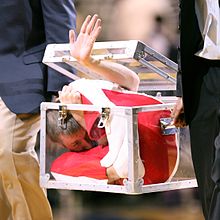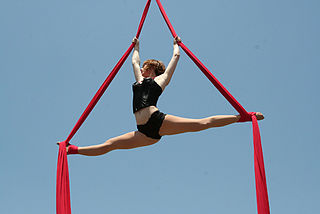
Acrobatics is the performance of human feats of balance, agility, and motor coordination. Acrobatic skills are used in performing arts, sporting events, and martial arts. Extensive use of acrobatic skills are most often performed in acro dance, circus, gymnastics, and freerunning and to a lesser extent in other athletic activities including ballet, slacklining and diving. Although acrobatics is most commonly associated with human body performance, the term is used to describe other types of performance, such as aerobatics.

Chinese variety art refers to a wide range of acrobatic acts, balancing acts and other demonstrations of physical skill traditionally performed by a troupe in China. Many of these acts have a long history in China and are still performed today.
A layback spin is a variation of the upright spin, a spin in figure skating. British figure skater Cecilia Colledge was "responsible for the invention" of the spin and the first to execute it. Colledge's coach, Jacques Gerschwiler, who was a former gymnastics teacher and according to Colledge "very progressive in his ideas", got the idea for the upright spin while watching one of Colledge's trainers, a former circus performer turned acrobatics instructor, train Colledge to perform backbends "by means of a rope tied around her waist". The upright spin has long been associated with women's skating, but men have also performed it. Skaters include it in their programs because it increases their technical content and fulfills choreographic needs.

Adagio is the performance of partner acrobalance poses and associated movements that involve stationary balances by a pair of performers. It is performed in professional circus, in various dance disciplines including acro dance and ballet, in pair skating, and as a hobby in university circus groups.
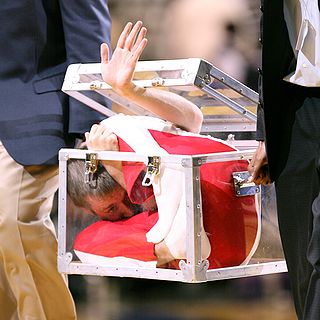
A frontbend is a contortion position where the body is curved forward at the hips and spine. In an extreme frontbend, some contortionists can place the backs of their knees behind their shoulders.

A kip-up is an acrobatic move in which a person transitions from a supine, and less commonly, a prone position, to a standing position. It is used in activities such as breakdancing, acro dance, gymnastics, martial arts, professional wrestling, and freerunning, and in action film fight sequences.
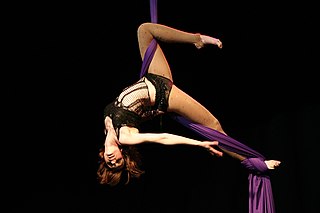
Aerial silks is a type of performance in which one or more artists perform aerial acrobatics while hanging from a specialist fabric. The fabric may be hung as two pieces, or a single piece, folded to make a loop, classified as hammock silks. Performers climb the suspended fabric without the use of safety lines and rely only on their training and skill to ensure safety. They use the fabric to wrap, suspend, drop, swing, and spiral their bodies into and out of various positions. The fabric may also be used to fly through the air, striking poses and figures. Some performers use rosin on their hands and feet to increase the friction and grip on the fabric. Aerial silks is a demanding art and requires a high degree of strength, power, flexibility, courage, stamina, and grace to practice.

A split is a physical position in which the legs are in line with each other and extended in opposite directions. Splits are commonly performed in various athletic activities, including dance, figure skating, gymnastics, contortionism, synchronized swimming, cheerleading, martial arts, aerial arts and yoga as exercise, where a front split is named Hanumanasana and a side split is named Samakonasana. A person who has assumed a split position is said to be "in a split", or "doing the splits", or "doing a split".

Salabhasana or Purna Salabhasana, Locust pose, or Grasshopper pose is a prone back-bending asana in modern yoga as exercise.
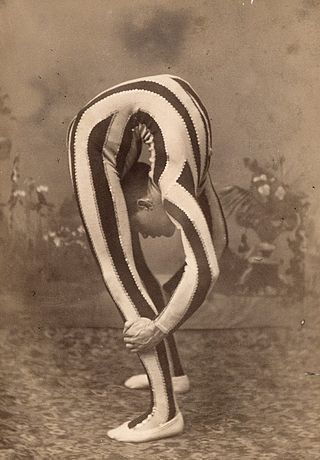
A backbend is a gymnastics, contortion, dance and ice skating move, where the spine is bent backwards, and catching oneself with the hands. Throughout the move, the abdominal muscles, obliques, and legs are used to steady the performer while curving backwards. Modern yoga includes some backbending asanas. Backbending can be acquired from intense training or genetics.

Acro dance is a style of dance that combines classical dance technique with acrobatic elements. It is defined by its athletic character, its unique choreography, which blends dance and acrobatics, and its use of acrobatics in a dance context. It is a popular dance style in amateur competitive dance as well as in professional dance theater and in contemporary circus productions such as those by Cirque du Soleil. This is in contrast to acrobatic, artistic and rhythmic gymnastics, which are sports that employ dance elements in a gymnastics context under the auspices of a governing gymnastics organization and subject to a Code of Points. Acro dance is known by various other names including acrobatic dance and gymnastic dance, though it is most commonly referred to simply as acro by dancers and dance professionals.
Marinelli bend is a form of contortion posture in which the performer supports their whole body weight only by biting onto a mouth grip attached to a short post in a backbend position with their buttocks sitting on their own head. It is considered to be one of the most difficult and dangerous contortion positions, and is usually the climax during a contortion performance.
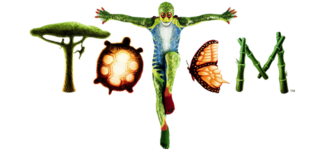
Totem is a touring show by Cirque du Soleil that premiered in Montréal on April 22, 2010. It was written and directed by previous collaborator Robert Lepage (Kà). Cirque du Soleil describes Totem's theme as the evolution of humanity from its primordial, amphibian state toward the aspiration of flight, taking inspiration from many of humanity's founding myths. The show was awarded the 2013 New York Drama Desk Award for Unique Theatrical Experience.
Aleksei I. Goloborodko is a Russian contortionist. In addition to contortion, he has trained in classical and modern dance and Chinese martial arts. He has performed in a variety of arts festivals and competitions, television programs, circuses, and shows. He is currently in the Cirque du Soleil show Luzia.

Christine Danton (Shillaker), professionally billed as "The Amazing Cristina" is an Australian contortionist who still performed her contortion act at the age of 71 in 2016. Celebrating over 50 years as a professional performer, Christine has been featured on several TV Shows, including "Just for the Record" and "Australia's Got Talent", and has worked internationally in theatre, film and circus. In the early 1960s while performing in Europe, Christine was asked to pose for the medical journal "Hypermobility of Joints", and it was those b&w images that were used in early editions of that publication. Christine performs her contortion act on a regular basis and is also in great demand as an "After Dinner Speaker".
(Kamal) Matt Alaeddine is a Canadian-based entertainer from Edmonton, Alberta who is the world's fattest contortionist. He has travelled around the world performing in a variety of venues. After getting his start at the Edmonton Fringe Festival, he has gone on to appear on The Tonight Show with Jay Leno, Canada's Got Talent, and Comedy Central's Gong Show. He holds the world records for "Heaviest Man to Touch Own Feet to Ears" and "Heaviest Man to Fit Through a Hula Hoop."
Hand to hand acrobatics is a type of performance in which an acrobatic base and flyer balance on top of each other in either a gymnastic or acrobatic medium. It combines strength, agility, flexibility, and balance. For it to be considered hand to hand acrobatics, the top performer (flyer) must be making physical contact only with the base's hands, with the flyer's hands keeping them balanced. Positions the top can perform in this style of acrobatics are straddles, handstands, pikes, press to handstand, one arm handstands, planches, flags, and many others. Hand to hand acrobatics can also include dynamic catches and throws that either begin with a throw from a hand to hand position or end in a catch in the hand to hand position.

Sofie Clarice Dossi is an American contortionist, aerialist, YouTuber, dancer, singer, and internet personality. In 2016, she rose to fame on the eleventh season of America's Got Talent. As of May 2023, her YouTube channel has 9.44 million subscribers and 1.6 billion views.

